GB1- Chapter 11
1/18
Earn XP
Description and Tags
Cell Communication
Name | Mastery | Learn | Test | Matching | Spaced |
|---|
No study sessions yet.
19 Terms
local signaling- direct contact
direct contact
cell junctions- allows molecules to pass through without going through plasma membranes
ex) gap junctions in animal cells/ plasmodesmata in plant cells
cell surface molecules- cell surface molecules interact with each other
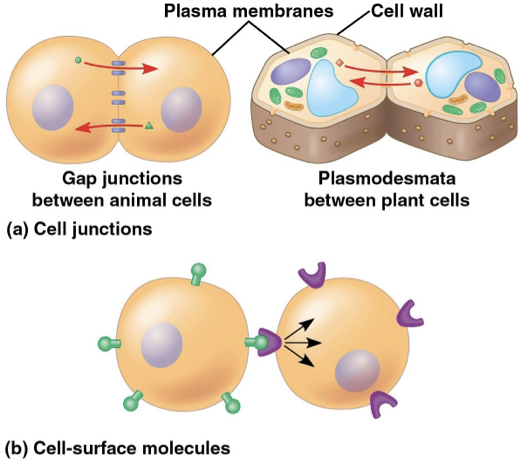
local signaling- secreted messenger
secreted messenger- travels short distances.
paracrine signaling- animal cells secreting messengers “para”- around
Growth Factors-stimulates nearby target cells to grow and divide
autocrine signaling- cell secretes signaling molecules that bind receptors to its own surface= alters its own behavior
synaptic signaling- an animal nervous system where electric signal releases a neurotransmitter/ used to treat depression, anxiety, PTSD
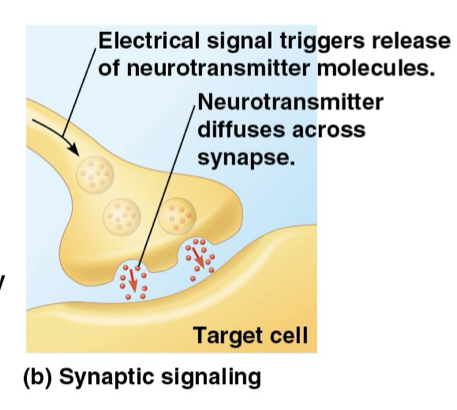
Long Distance Signaling
Hormones travel to target cells through the circulatory system. Cells can only respond to the hormone signals if they have the correct receptor proteins
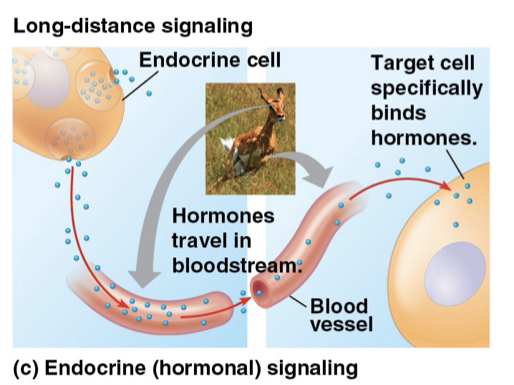
Three stages of cell signaling
signal reception- cell surface receptor protein detects signal. The binding of a ligand (signal molecule) to the receptor is highly specific. Most receptors are on plasma membrane but some are in nucleus and cytoplasm.
signal transduction- The alteration of receptor shape due to the binding of the signal to the receptor is the first step to transduction. This initiates a multi-step signal transduction pathway
cellular response- a specific response in the target cell
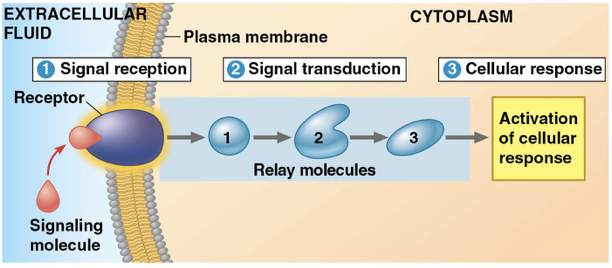
membrane receptors
receptor proteins have specific sites where most water soluble molecules can transmit information from extracellular to intercellular environment
G protein coupled receptors- largest family, all G proteins are all very similar in structure, extremely wide spread and diverse functions
receptor tyrosine kinases
ion channel receptors
G protein coupled receptors
signaling molecule activates receptors
G protein is activated by GTP
The activated G protein moves and activates an enzyme
The activated enzyme produces a cellular response
GTPase hydrolyzes GTP into GDP and a phosphate group
allows pathways to shut down quickly when G protein leaves
Receptor tyrosine kinases (RTKs)
signaling molecules attach to receptors. dimerization- monomers come together as dimers
dimer’s tyrosine kinase regions are activated- unphosphorylated dimer
6 ATP drops off phosphate groups
dimer’s tyrosine kinase regions are fully activated- phosphorylated dimer
attracts relay proteins, triggering a transduction pathway that leads to cellular response.
Ligand- gated ion channel
signal molecule (ligand) attaches to receptor, changing its shape
the ion channel is opened when ligand is binded. specific ions like Na or Ca moves through.
ion channel is closed when the ligand falls off
intercellular receptor proteins
found in the nucleus or cytosol. Only small or hydrophobic molecules can cross the membrane and activate receptors. The activated receptors work as a transcription factor that turns genes on and off.

multistep process
can amplify a signal, allows for more detailed coordination and regluation
signal transduction pathways
phosphorylation cascade
signal molecule binds to a receptor in the first step
activated receptor activates another receptor and so on until the producing response is activated
Protein phosphorylation and dephosphorylation
protein phosphatases- regulates protein activity by turning it on/off
second messengers
small, nonprotein water-soluble molecules that spread throughout the cell through diffusion
are used in GPCRs and RTKs
Cyclic AMP- second messenger
produced from ATP
G-Protein coupled receptors activate adenylyl cyclase
adenylyl cyclase- an enzyme in plasma membrane converts ATP to cAMP in response to extracellular signal
cAMP activates protein kinase A
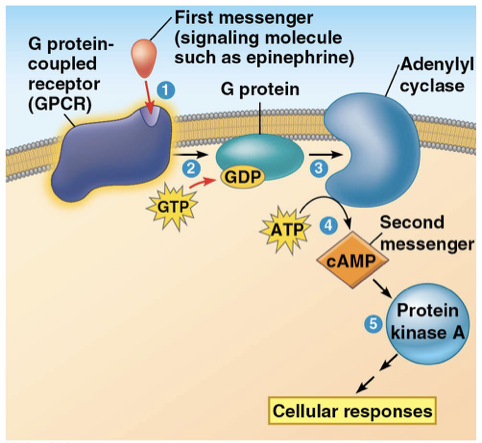
Vibrio Cholerae
modifies G protein so that it’s stuck in its active form so that it continually makes cAMP. the constant secretion of cAMP causes large amounts of salt to be released into the intestines. Water is lost through osmosis and the person dies from loss of water and salt.
Calcium ions (Ca2+)- second messenger
calcium ion concentration is much higher outside the cell than inside the cytosol. Any small calcium number change represents a relatively large percentage change in calcium concentration. A signal from the signal transduction pathway may increase calcium in the cytosol.
inositol triphosphate (IP3) and diacylglycerol (DAG) also work as second messengers used in the three signal transduction pathways
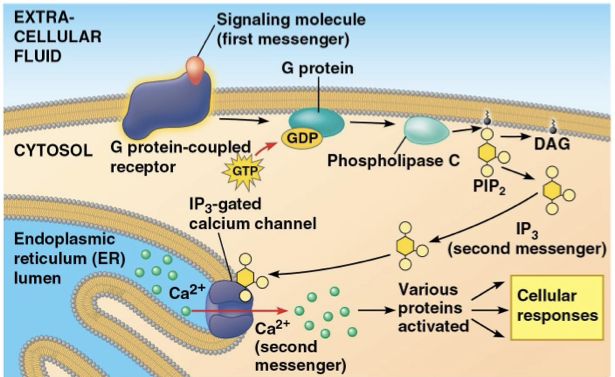
cellular response in nucleus or cytoplasm
nucleus- signaling pathways regulate enzyme synthesis by turning genes on/off.
the final activated molecule in the signaling pathway can function as a transcription factor for DNA
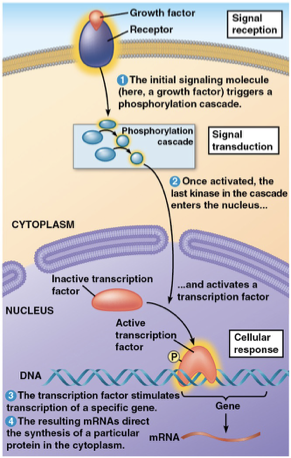
signal could cause
opening or closing of an ion channel in the plasma membrane or a change in metabolic enzyme activity
four aspects of signal regulation
amplification of the signal- enzyme cascade amplifies cell response to the signal. the number of activated products can be much greater than in the previous step.
specificity of the response- different cells have different proteins that allow for detection and response to different signals. The same signal can have different effects in cells with different proteins and pathways.
efficiency of response- scaffold proteins- large relay proteins to which several other relay proteins are attached. increases efficiency by grouping different proteins in the same pathway.
termination of the signal- low concentration of signaling molecules would only bind to few receptors. The unbound receptors revert to their old state.
apoptosis
Programmed cell death for infected, damaged, or cells that are at the end of their functional lives.
cell components are chopped up and packaged into vesicles that are digested by scavenger cells. This is to prevent dying enzymes from leaking out and damaging neighboring cells
ex) a normal part of hand and foot development
relations with Parkinson’s and Alzheimer’s as well as some cancers
